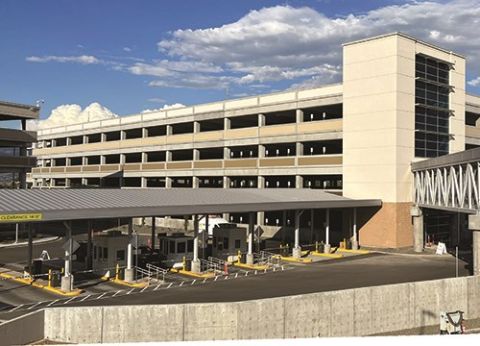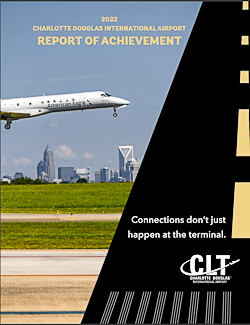Boise Airport Expands Parking for Growing Local Population

Nicknamed Treasure Valley for its vast natural resources, Boise, ID, is having a moment. The Boise metro area consistently shows up on lists of the fastest-growing areas in the U.S., and Boise Airport (BOI) is making investments to handle the associated traffic increases.
 Deputy Director of Parking and Landside Facilities Sean Briggs, a local native and 10-year airport veteran, isn’t surprised that the area is booming. “Boise is a great place to live,” Briggs says. “We have phenomenal weather, and it’s a clean, safe city. The growth of the region is pretty impressive.”
Deputy Director of Parking and Landside Facilities Sean Briggs, a local native and 10-year airport veteran, isn’t surprised that the area is booming. “Boise is a great place to live,” Briggs says. “We have phenomenal weather, and it’s a clean, safe city. The growth of the region is pretty impressive.”
As the local population surges—to the tune of about 80% in the last decade, Briggs says—BOI is opening its arms widely to welcome additional travelers. Like an expanding family, the airport needed an addition to its “house” to provide space for more vehicles. As part of a multiyear capital improvement plan to increase parking, terminal and gate capacity, BOI commissioned a five-level employee parking garage with more than 700 spaces, and a five-level, 1,148-stall public garage. Dubbed the East Garage, the public parking facility includes a new administrative office and parking exit plaza.
|
Project: Increase Parking Capacity Location: Boise Int’l Airport Total Cost: $60 million Owner & Funding Source: City of Boise, ID East Public Garage Size: 5 levels Capacity: 1,148 spaces Opened: July 2023 Employee Garage Size: 5 levels Capacity: 700+ spaces Opened: April 2024 Design/Architect of Record: CSHQA Construction: MacAlvain Structural Engineer/Engineer of Record: Walker Consultants Civil Engineering: Ardurra Group Geotechnical Consultant: Terracon Key Benefits: Much-needed additional parking capacity to accommodate increased customer volume |
It’s not a “build it and they will come” era for BOI. People are already showing up in droves, and having enough parking is already improving the overall passenger experience. Getting to this point required a great deal of patience, grit and strategy. Now that both garages are finished, the BOI team can take a breath and start planning for the next influx.
Function and Form
The airport spent $60 million of its own money to design and build this two-year project. Both new structures were engineered to be highly functional and visually stunning: the employee garage, which faces a nearby highway, is adorned with a river design to represent the Boise River Valley. Not far away, the rooftop spaces of the East Garage afford views of the city skyline, nearby foothills, airport terminals and airfield runways. Ardurra Group, the civil and landscape firm that worked on the project under designer/architect of record CSHQA, helped enhance the aesthetics.
“I really liked how the landscaping turned out in front of the employee garage,” says Justin Bilbrey, a designer from Ardurra. “We installed some custom 8-foot-wide planters along the north side of the garage facing the freeway, and it serves as a nice visual.”
The garage project has been in the works for quite some time. The airport kicked it off with design work in 2019 and had planned to start construction in 2020, but the global COVID crisis decimated travel for several months. Taking a beat, BOI executives decided to pause the plan until they could get a better feel for when traffic might return to pre-2020 levels. When the project resumed in 2021, they came up with a strategy to help airport operations continue unabated.
The airport signed a two-year lease for a nearby parking lot, purchased shuttles and hired drivers to transport employees back and forth. Valet parking added about 200 spaces for the public, and BOI braced for a squeeze. During Spring Break this year, close-in parking was completely full, and the economy lot had fewer than 100 spaces left at peak. Not surprisingly, managing demand and inventory was in sharp focus. Behind the scenes, the project required traffic pattern adjustments.
 “For the construction of the East public garage, we had to reroute short-term parking traffic through the existing garage,” Briggs explains. “We cut out a wall and built a temporary road to reconstruct the exit and toll plaza, which was unique and challenging.”
“For the construction of the East public garage, we had to reroute short-term parking traffic through the existing garage,” Briggs explains. “We cut out a wall and built a temporary road to reconstruct the exit and toll plaza, which was unique and challenging.”
The asphalt road was in place for four to five months while crews built the new pedestrian bridge, toll plaza and ticket office. Then, the temporary road was dismantled and the garage wall rebuilt. After the ticket office and surface parking were ready, traffic resumed on its original path.
D vs. O
 Walker Consultants helped the design team win the project bid with an alternate ramping system it says saved BOI $3 million to $5 million. Instead of sticking with the circular ramp in the original proposal, Designer Darrell Gallegos and the team from Walker suggested a ramp that looks like the letter D from above, because its conventional framing decreases construction time and cost. In contrast, a circular ramp would have required much more concrete due to its shape and construction requirements.
Walker Consultants helped the design team win the project bid with an alternate ramping system it says saved BOI $3 million to $5 million. Instead of sticking with the circular ramp in the original proposal, Designer Darrell Gallegos and the team from Walker suggested a ramp that looks like the letter D from above, because its conventional framing decreases construction time and cost. In contrast, a circular ramp would have required much more concrete due to its shape and construction requirements.
“The existing garage has two single-threaded helices—one inbound and one outbound,” explains Engineer of Record Bob Stanley. “For the size structure we were building, the original concept had shown two more helices, and that was going to be overkill. Instead, we combined those into one singular helix. It’s more constructible and still drives well.”
Formwork and concrete construction are very expensive, Stanley explains, so to have two sets of formwork would have negatively impacted the budget.
“With the D ramps, we are able to accommodate the same amount of traffic and not take up a larger footprint,” notes BOI Project Manager Jill Singer.
After winning the bid, the CSHQA/Walker/Ardurra team started mapping out the plan.
 “At any airport, the challenge is to try to keep the airport running every single day during the process,” says Stanley. “We figured out a phasing plan that made sense to minimize disruption and came up with three main phases of the project.”
“At any airport, the challenge is to try to keep the airport running every single day during the process,” says Stanley. “We figured out a phasing plan that made sense to minimize disruption and came up with three main phases of the project.”
As the project progressed, BOI knew the crowding would get worse before it got better.
“I think the biggest challenge was that we had to take parking stalls out of our overall capacity,” says Briggs. “We were at a point where we were strained already and had to remove parking stalls.”
Martin Hahle, the architect of record from CSHQA, was attuned to the challenge. “People had become so accustomed to readily finding a parking space in the past, and they would be shocked when there wasn’t parking available,” he explains. “They’d miss flights because they didn’t have time to park at a remote lot. Now, the community is very excited and the new parking structure has restored the airport to a place where they could count on having parking available.”
 On that note, Stanley emphasizes the importance of working with project partners that have experience in the airport sector. “There are a lot of things happening at an airport, and you really do need to have people who are experts in this to guide the process to keep the costs under control and make sure there are no surprises,” he advises.
On that note, Stanley emphasizes the importance of working with project partners that have experience in the airport sector. “There are a lot of things happening at an airport, and you really do need to have people who are experts in this to guide the process to keep the costs under control and make sure there are no surprises,” he advises.
Environmental Twist
A capped landfill on airport property presented the project team with an added challenge. BOI commissioned a soil report from environmental consulting firm Terracon to evaluate the risk for volatile organic compounds (VOCs) and help determine how to proceed.
“We put in a VIMS [vapor intrusion mitigation system] in case something became a VOC that needed to be monitored,” Singer says. “We thought that was cheap insurance. We have all the piping, so if and when the Idaho Department of Environmental Quality requests a courtesy monitoring report in five, 10, or 15 years, we have the ability to do that monitoring.”
Terracon oversaw the testing and material removal while excavating 18 to 20 feet deep in the landfill area.
“They removed any waste material that would organically break down over time and release gases,” Hahle says. “And we positioned the garage to have very little overlap with the landfill.”
Documenting and testing the soil around the landfill was critical to define any unknowns, Stanley emphasizes. Engineers determined what kind of weight that patch of land could hold, and Walker consequently recommended a ground improvement process that compacts the soil to minimize settling after the structure is built. In addition, engineers chose rectangular footings, rather than drilled footings, to spread the weight evenly and impact smaller areas of the ground.
From there, Walker specified post-tension concrete structures, which use high-strength steel cables to allow concrete to span longer distances and remain highly durable, lowering the overall cost of ownership. Project designers selected precast concrete panels for the exterior barrier walls because they’re manufactured under controlled conditions with forms that create a smooth product with minimal imperfections.
Takeaways
Singer says the team learned a great deal by working closely with the airport’s utility departments and securing their buy-in early on.

“We were coming out of post-pandemic workforce issues, and everyone was about two years behind,” she recalls. “We needed to work with utility contractors to relocate telephone cables, water lines, gas and more. Understanding timelines and working together were the biggest lessons learned. We can have the best schedule in the world, but if we don’t have buy-in from the utility stakeholders, it’s just a chart with pretty colors.”
Team members agree that oversight and communication were also key factors. Differentiating between “needs” and “wants” helped the team distill the plan, and building in contingencies for things like permit costs provided valuable breathing room.
Project leaders acknowledged the reality that mistakes happen, Singer explains. “Having those contingencies built into the budget and creating an approval process to use those allowances was a great way to have those conversations right up front.”
Briggs and Singer praise the general contractor, MacAlvain, for being communicative about its concerns from the start.
“You go in with the best intentions,” Singer says. “Everyone starts as best friends, because you want to do the best thing. Then you have to figure out how you’re going to build that relationship. You want to finish by shaking hands and looking forward to the next project.”

Ultimately, both parking garage projects were finished on time and on budget. So BOI leadership can breathe a sigh of relief while the airport begins recouping its investment.
“Parking revenue counts for more than 30% of our total revenue,” Briggs says. “Already we’ve seen parking revenue increased 25% year to date. We also have fewer expenses: fewer shuttles, less fuel and less maintenance overall.”
Bilbrey, from Ardurra, is pleased by the outcome and sees the additional parking as a way for BOI to prepare for the future.
“The population has grown like crazy out here and as part of that, the airport is getting busier,” he says. “As they look to add new flights, I think this is just good for everybody here.”
Already in the midst of more improvements to accommodate growing traffic, BOI is replacing its current rental car facility to clear the way for a major concourse expansion. The new seven-level consolidated rental car center, designed by HDR and Demattei Wong Architecture, is expected to have more than 1,000 read/return spaces, self-service customer kiosks and an enclosed walkway that connects to the terminal. Total cost is estimated at more than $90 million.
2022 Charlotte Douglas International Airport Report of Achievement
 Giving back to the community is central to what Charlotte Douglas International Airport and its operator, the City of Charlotte Aviation Department, is about, and last year was no different.
Giving back to the community is central to what Charlotte Douglas International Airport and its operator, the City of Charlotte Aviation Department, is about, and last year was no different.
Throughout 2022, while recovering from the COVID-19 pandemic, we continued our efforts to have a positive impact on the Charlotte community. Of particular note, we spent the year sharing stories of how Connections Don't Just Happen at the Terminal - from creating homeownership and employment opportunities to supporting economic growth through small-business development and offering outreach programs to help residents understand the Airport better.
This whitepaper highlights the construction projects, initiatives, programs and events that validate Charlotte Douglas as a premier airport.
Download the whitepaper: 2022 Charlotte Douglas International Airport Report of Achievement.
 facts&figures
facts&figures








